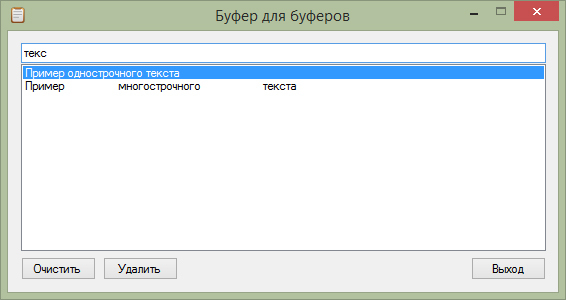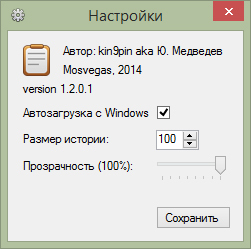Buffer for buffers or write a virtual clipboard in C # not in 30 lines of code

It so happened that in such gloomy weather, having overlaid myself with pills and cold medications, I decided to share with the habr-community a tool I had made for myself and had been using it for almost a month now. This is a windows program that intercepts text copying to the clipboard and allows you to paste any fragment from the previously copied text.
How it all began
Like any programmer, I constantly have to work with the code. Besides writing C # code, I constantly have to write sql queries. Moreover, quite complex queries: queries with subqueries, with subqueries, with a bunch of LEFT JOIN and RIGHT JOINs. Making a decomposition of such requests into its separate parts, it is easy to get confused as to what and why / why all this was written.A typical example of one sql query (do not even try to understand what it does)
SELECT IFNULL(SUM(t_step3.half_step3 - IFNULL(t_step1.bonus, 0) - IFNULL(t_step2.bonus, 0)), 0) AS 'bonus' FROM ( SELECT t_orders2cat.order_id AS 'id', (t_o.balance_rub - SUM(t_orders2cat.dprice_rub - t_orders2cat.delivery_cost_rub) - IFNULL(t_gurkin.half_step3, 0) - IFNULL(t_o2p.cost_expenses_rub, 0)) * ( IF(base_on_tender = 0, IFNULL(t_category_percent.percent, 1), IF(base_on_tender = 1, IFNULL(t_category_percent.percent, 1) - 0.1, IFNULL(t_category_percent.percent, 1) - 0.5) ) - IF(t_orders.tech_helper_id != 0, t_users.tech_bonus_percent, 0) ) / 100 AS 'half_step3' FROM t_orders2cat, t_orders LEFT JOIN t_category_percent ON t_orders.category_percent_id = t_category_percent.id LEFT JOIN t_users ON t_orders.tech_helper_id = t_users.id LEFT JOIN (SELECT order_id, SUM(cost_expenses_rub) AS 'cost_expenses_rub' FROM t_orders2pnr GROUP BY t_orders2pnr.order_id HAVING SUM(cost_expenses_rub) > 0) AS t_o2p ON t_orders.id = t_o2p.order_id LEFT JOIN ( SELECT t_orders.id AS 'order_id', SUM(deg_discount(deg_convert_money( t_orders.rate_eur, t_orders.rate_usd, t_orders.rate_jpy, t_orders2cat.price, t_orders2cat.currency_id, t_orders.currency_id), t_orders2cat.discount) * t_orders2cat.count - t_orders2cat.dprice_rub - t_orders2cat.delivery_cost_rub - IFNULL(t_orders2pnr.cost_expenses_rub, 0) ) * t_p.balance_rub / t_orders.balance AS 'half_step3' FROM t_orders LEFT JOIN t_orders2pnr ON t_orders.id = t_orders2pnr.order_id, t_orders2cat, t_cat, t_vendors, ( SELECT order_id, SUM(summa_rub) AS 'balance_rub' FROM t_payments GROUP BY order_id ) AS t_p, ( SELECT t_o.id, GREATEST(IFNULL(t_o.date_shipment, t_o.date_pnr_finish), IFNULL(t_o.date_pnr_finish, t_o.date_shipment), MAX(t_payments.date_payment)) AS 'date_closed', SUM(t_payments.summa_rub) AS 'balance_rub' FROM t_payments, ( SELECT t_orders.id, COUNT(t_orders2cat.id) AS 'orders2cat_count', MAX(t_orders2cat.date_from) AS 'date_shipment', MAX(t_orders2cat.status_id) AS 'orders2cat_status', COUNT(t_orders2pnr.id) AS 'pnr_count', MAX(t_orders2pnr.date) AS 'date_pnr_finish', MAX(t_orders2pnr.status_id) AS 'pnr_status' FROM t_orders LEFT JOIN t_orders2cat ON t_orders.id = t_orders2cat.order_id LEFT JOIN t_orders2pnr ON t_orders.id = t_orders2pnr.order_id WHERE t_orders.user_id = in_user_id AND t_orders.items_finished >= t_orders.items_count AND t_orders.summa - t_orders.balance < 2 GROUP BY t_orders.id ) AS t_o WHERE t_payments.order_id = t_o.id GROUP BY t_payments.order_id HAVING EXTRACT(YEAR_MONTH FROM date_closed) = EXTRACT(YEAR_MONTH FROM in_date) ) AS t_o WHERE t_orders.id = t_o.id AND t_orders.id = t_p.order_id AND t_orders.id = t_orders2cat.order_id AND t_orders2cat.cat_id = t_cat.id AND t_orders.user_id = in_user_id AND t_cat.vendor_id = t_vendors.id AND t_vendors.user_id = 158 GROUP BY t_orders.id ) AS t_gurkin ON t_orders.id = t_gurkin.order_id, ( SELECT t_o.id, GREATEST(IFNULL(t_o.date_shipment, t_o.date_pnr_finish), IFNULL(t_o.date_pnr_finish, t_o.date_shipment), MAX(t_payments.date_payment)) AS 'date_closed', SUM(t_payments.summa_rub) AS 'balance_rub' FROM t_payments, ( SELECT t_orders.id, COUNT(t_orders2cat.id) AS 'orders2cat_count', MAX(t_orders2cat.date_from) AS 'date_shipment', MAX(t_orders2cat.status_id) AS 'orders2cat_status', COUNT(t_orders2pnr.id) AS 'pnr_count', MAX(t_orders2pnr.date) AS 'date_pnr_finish', MAX(t_orders2pnr.status_id) AS 'pnr_status' FROM t_orders LEFT JOIN t_orders2cat ON t_orders.id = t_orders2cat.order_id LEFT JOIN t_orders2pnr ON t_orders.id = t_orders2pnr.order_id WHERE t_orders.user_id = in_user_id AND t_orders.items_finished >= t_orders.items_count AND t_orders.summa - t_orders.balance < 2 GROUP BY t_orders.id ) AS t_o WHERE t_payments.order_id = t_o.id GROUP BY t_payments.order_id HAVING EXTRACT(YEAR_MONTH FROM date_closed) = EXTRACT(YEAR_MONTH FROM in_date) ) AS t_o WHERE t_orders2cat.order_id = t_o.id AND t_orders2cat.order_id = t_orders.id GROUP BY t_orders2cat.order_id ) AS t_step3 LEFT JOIN ( SELECT t_orders.id, t_o.average_curs * (t_orders.summa - IFNULL(t_gurkin.step1, 0)) * ( IF(base_on_tender = 0, IFNULL(t_category_percent.percent, 1), IF(base_on_tender = 1, IFNULL(t_category_percent.percent, 1) - 0.1, IFNULL(t_category_percent.percent, 1) - 0.5 ) ) - IF(t_orders.tech_helper_id != 0, t_users.tech_bonus_percent, 0) ) / 100 * 0.3 AS 'bonus' FROM t_orders LEFT JOIN t_category_percent ON t_orders.category_percent_id = t_category_percent.id LEFT JOIN t_users ON t_orders.tech_helper_id = t_users.id LEFT JOIN ( SELECT t_orders.id AS 'order_id', SUM(deg_discount(deg_convert_money( t_orders.rate_eur, t_orders.rate_usd, t_orders.rate_jpy, t_orders2cat.price, t_orders2cat.currency_id, t_orders.currency_id), t_orders2cat.discount) * t_orders2cat.count) * t_o.payment_rub / t_o.payment_currency AS 'step1' FROM t_orders, t_orders2cat, t_cat, t_vendors, ( SELECT t_orders.id, SUM(t_payments.summa_rub) AS 'payment_rub', SUM(deg_convert_money(t_rates.eur, t_rates.usd, t_rates.jpy, t_payments.summa_rub, 1, t_orders.currency_id)) AS 'payment_currency', t_orders.summa FROM t_orders, t_payments, t_rates WHERE t_orders.id = t_payments.order_id AND t_payments.date_rates = t_rates.date AND EXTRACT(YEAR_MONTH FROM t_orders.date_firstpay) = EXTRACT(YEAR_MONTH FROM t_payments.date_payment) GROUP BY t_payments.order_id HAVING payment_currency / t_orders.summa >= 0.3 ) AS t_o WHERE t_orders.id = t_orders2cat.order_id AND t_orders2cat.order_id = t_o.id AND t_orders.user_id = in_user_id AND t_orders2cat.cat_id = t_cat.id AND t_vendors.user_id = 158 AND t_cat.vendor_id = t_vendors.id GROUP BY t_o.id ) AS t_gurkin ON t_orders.id = t_gurkin.order_id, ( SELECT t_orders.id, SUM(t_payments.summa_rub) / SUM(deg_convert_money(t_rates.eur, t_rates.usd, t_rates.jpy, t_payments.summa_rub, 1, t_orders.currency_id)) AS 'average_curs' FROM t_payments, t_rates, t_orders, ( SELECT t_payments.order_id, MIN(t_payments.date_payment) AS 'date_payment' FROM t_payments WHERE 0.3 <= ( SELECT SUM(deg_convert_money(t_rates.eur, t_rates.usd, t_rates.jpy, t_p.summa_rub, 1, t_o.currency_id)) / t_o.summa AS 'summa_cur' FROM t_payments AS t_p, t_orders AS t_o, t_rates WHERE t_p.order_id = t_o.id AND t_p.date_rates = t_rates.date AND t_p.date_payment <= t_payments.date_payment AND t_o.id = t_payments.order_id ) GROUP BY t_payments.order_id ) AS t_o WHERE t_payments.order_id = t_o.order_id AND t_payments.order_id = t_orders.id AND t_payments.date_rates = t_rates.date AND EXTRACT(YEAR_MONTH FROM t_payments.date_payment) <= EXTRACT(YEAR_MONTH FROM t_o.date_payment) AND t_orders.user_id = in_user_id GROUP BY t_orders.id ) AS t_o WHERE t_orders.id = t_o.id AND t_orders.user_id = in_user_id ) AS t_step1 ON t_step3.id = t_step1.id LEFT JOIN ( SELECT t_orders.id, SUM(t_payments.summa_rub) / SUM(deg_convert_money(t_rates.eur, t_rates.usd, t_rates.jpy, t_payments.summa_rub, 1, t_orders.currency_id)) * (t_orders.summa - IFNULL(t_gurkin.step2, 0)) * ( IF(base_on_tender = 0, IFNULL(t_category_percent.percent, 1), IF(base_on_tender = 1, IFNULL(t_category_percent.percent, 1) - 0.1, IFNULL(t_category_percent.percent, 1) - 0.5 ) ) - IF(t_orders.tech_helper_id != 0, t_users.tech_bonus_percent, 0) ) / 100 * 0.3 AS 'bonus' FROM t_payments, t_rates, t_orders LEFT JOIN t_category_percent ON t_orders.category_percent_id = t_category_percent.id LEFT JOIN t_users ON t_orders.tech_helper_id = t_users.id LEFT JOIN ( SELECT t_orders.id AS 'order_id', SUM(deg_discount(deg_convert_money( t_orders.rate_eur, t_orders.rate_usd, t_orders.rate_jpy, t_orders2cat.price, t_orders2cat.currency_id, t_orders.currency_id), t_orders2cat.discount) * t_orders2cat.count) * t_o.payment_rub / t_o.payment_currency AS 'step2' FROM t_orders, t_orders2cat, t_cat, t_vendors, ( SELECT t_orders.id, SUM(t_payments.summa_rub) AS 'payment_rub', SUM(deg_convert_money(t_rates.eur, t_rates.usd, t_rates.jpy, t_payments.summa_rub, 1, t_orders.currency_id)) AS 'payment_currency' FROM t_payments, t_rates, t_orders, ( SELECT t_o.id, GREATEST(date_exit, date_payment) AS 'date_payment_bonus' FROM ( SELECT t_o.id AS 'id', MAX(t_containers.date_port_exit) AS 'date_exit' FROM t_orders2cat, t_invoices2orders2cat, t_containers2invoices, t_containers, ( SELECT t_orders.id FROM t_orders, t_orders2cat WHERE t_orders.id = t_orders2cat.order_id AND t_orders.user_id = in_user_id AND 4 <= ALL (SELECT t_o2c.status_id FROM t_orders2cat AS t_o2c WHERE t_o2c.order_id = t_orders.id) GROUP BY t_orders.id ) AS t_o WHERE t_orders2cat.id = t_invoices2orders2cat.order2cat_id AND t_invoices2orders2cat.invoice_id = t_containers2invoices.invoice_id AND t_containers2invoices.container_id = t_containers.id AND t_orders2cat.order_id = t_o.id GROUP BY t_o.id ) AS t_o, ( SELECT t_payments.order_id, MIN(t_payments.date_payment) AS 'date_payment' FROM t_payments WHERE 0.8 <= ( SELECT SUM(deg_convert_money(t_rates.eur, t_rates.usd, t_rates.jpy, t_p.summa_rub, 1, t_o.currency_id)) / t_o.summa AS 'summa_cur' FROM t_payments AS t_p, t_orders AS t_o, t_rates WHERE t_p.order_id = t_o.id AND t_o.user_id = in_user_id AND t_p.date_rates = t_rates.date AND t_p.date_payment <= t_payments.date_payment AND t_o.id = t_payments.order_id ) GROUP BY t_payments.order_id ) t_p WHERE t_o.id = t_p.order_id ) AS t_o WHERE t_payments.order_id = t_o.id AND t_payments.date_rates = t_rates.date AND t_payments.order_id = t_orders.id AND EXTRACT(YEAR_MONTH FROM t_payments.date_payment) <= EXTRACT(YEAR_MONTH FROM t_o.date_payment_bonus) GROUP BY t_orders.id ) AS t_o WHERE t_orders.id = t_orders2cat.order_id AND t_orders2cat.order_id = t_o.id AND t_orders2cat.cat_id = t_cat.id AND t_orders.user_id = in_user_id AND t_vendors.user_id = 158 AND t_cat.vendor_id = t_vendors.id GROUP BY t_o.id ) AS t_gurkin ON t_orders.id = t_gurkin.order_id, ( SELECT t_o.id, GREATEST(date_exit, date_payment) AS 'date_payment_bonus' FROM ( SELECT t_o.id AS 'id', MAX(t_containers.date_port_exit) AS 'date_exit' FROM t_orders2cat, t_invoices2orders2cat, t_containers2invoices, t_containers, ( SELECT t_orders.id FROM t_orders, t_orders2cat WHERE t_orders.id = t_orders2cat.order_id AND t_orders.user_id = in_user_id AND 4 <= ALL (SELECT t_o2c.status_id FROM t_orders2cat AS t_o2c WHERE t_o2c.order_id = t_orders.id) AND t_orders.user_id = in_user_id GROUP BY t_orders.id ) AS t_o WHERE t_orders2cat.id = t_invoices2orders2cat.order2cat_id AND t_invoices2orders2cat.invoice_id = t_containers2invoices.invoice_id AND t_containers2invoices.container_id = t_containers.id AND t_orders2cat.order_id = t_o.id GROUP BY t_o.id ) AS t_o, ( SELECT t_payments.order_id, MIN(t_payments.date_payment) AS 'date_payment' FROM t_payments WHERE 0.8 <= ( SELECT SUM(deg_convert_money(t_rates.eur, t_rates.usd, t_rates.jpy, t_p.summa_rub, 1, t_o.currency_id)) / t_o.summa AS 'summa_cur' FROM t_payments AS t_p, t_orders AS t_o, t_rates WHERE t_p.order_id = t_o.id AND t_o.user_id = in_user_id AND t_p.date_rates = t_rates.date AND t_p.date_payment <= t_payments.date_payment AND t_o.id = t_payments.order_id ) GROUP BY t_payments.order_id ) t_p WHERE t_o.id = t_p.order_id ) AS t_o WHERE t_o.id = t_payments.order_id AND t_orders.id = t_o.id AND t_orders.user_id = in_user_id AND t_payments.date_rates = t_rates.date AND EXTRACT(YEAR_MONTH FROM t_payments.date_payment) <= EXTRACT(YEAR_MONTH FROM t_o.date_payment_bonus) GROUP BY t_orders.id ) AS t_step2 ON t_step3.id = t_step2.id; After reading the article Writing a virtual clipboard in C # , I decided to try in action what yanzlatov offered us, but his version was unacceptable for me: in many ways, the inconvenience to the fast access of the buffers copied to the buffer, the glitch ...
')
Requirements
Having formulated clear requirements for what I needed, it was decided to re-write the bike.- Since I work on a laptop (Win7x64), on a home computer (Win8.1x64) and on a work computer (Win8x64), the developed application should work on three axes Windows 7x64, 8x64, 8.1x64 with .Net Framework version 4 and higher .
- The application must be silently loaded at the time of loading the OS
- When copying text to the clipboard, the application must save this text in memory.
- When inserting text (for example, by pressing ctrl + v or the corresponding menu item), the last text sent to the buffer should be inserted
- When you press ctrl + alt + v , a window should appear with a choice of buffer
- Buffer history should be maintained even after reboot.
- Full hotkey support is essential.
- Since the number of stored items can be huge, you need a convenient search through all items.
Code

The project source can be downloaded here . Exe file can be picked up here .
I will not focus on all the code. I will dwell on some points.
At the very beginning of the launch, a check is made with the help of a mutex so that another instance of the application is not running:
static void Main() { bool createdNew; Mutex mutex = new Mutex(true, "MY_UNIQUE_MUTEX_ClipboardToClipboard", out createdNew); if (!createdNew) { MessageBox.Show(" ", Application.ProductName, MessageBoxButtons.OK, MessageBoxIcon.Warning); Process.GetCurrentProcess().Kill(); } ... ... ... mutex.ReleaseMutex(); } The process of intercepting pressing the ctrl + alt + v combination
public static EventCtrlAltVHandler EventPressCtrlAltV; private static Keys lastKey = Keys.FinalMode; private static IntPtr HookCallback(int nCode, IntPtr wParam, IntPtr lParam) { if ((nCode >= 0) && (wParam == (IntPtr)WM_KEYDOWN)) { Keys key = (Keys)Marshal.ReadInt32(lParam); if (lastKey == Keys.LMenu && key == Keys.V) EventPressCtrlAltV(); lastKey = key; } return CallNextHookEx(_hookID, nCode, wParam, lParam); } In MainForm.cs there is a function that simulates pressing ctrl + { key }. In my case it was ctrl + v on the selected item from the list.
private static void SendCtrlhotKey(char key) { keybd_event(VK_CONTROL, 0, 0, 0); keybd_event((byte)key, 0, 0, 0); keybd_event((byte)key, 0, KEYEVENTF_KEYUP, 0); keybd_event(VK_CONTROL, 0, KEYEVENTF_KEYUP, 0); } In principle, there is nothing so special there. The history is stored in the xml-file, the settings are right in the properties of the application ... Who is interested in trying to see and figure out for yourself. If you have questions, I can answer them.
How in practice it all looks and works.
It's all very simple. Run exe-shnik. Select the text fragment, click ctrl + c and a notification appears in the system tray:
It would seem that this feature is useless, but behind it is a steeper feature - if you click on the pop-up help, a window will open with the possibility of adding a comment:

What to do with this comment, I will tell later.
Now suppose that we needed to paste the text that the FIG knows when it was copied to the clipboard. There is nothing easier - press ctrl + alt + v:

We can right there, moving the list with the keys up or down, select the text we need. At the same time, when moving in the list by elements, a tooltip appears, which can be useful if the text is multi-line. By the way, here is the comment that you could have indicated earlier:

Agree, a very handy feature when editing a Hindu code)
So, you have selected the item you want in the list. Now just press Enter and the text is inserted into the position of your editor where the cursor is.
In this main window, you can either delete the selected fragment by element using the Del key, or completely clear the entire buffer of buffers; You can set the selected item to comment using the ctrl + R combination.

Pressing escape, the window is hidden in the tray.
Separate attention deserves a search. If you need to find something in among the buffers, then you can quickly switch to the search: ctrl + alt + v -> ctrl + f. In this case, the focus is set in the search bar.

Enter a few key letters, press Enter -> now the focus will be on the list, where you can again move the keys up or down. If there is text in the search bar and there is text, then pressing escape clears the text field. Pressing escape again hides the window.
In the settings, nothing special. Somehow realized the level of transparency, thought it would be a useful feature. In fact, it turned out that there was little sense from her. Left it, but for myself, transparency left 100%:

Conclusion
I hope that my tool will be useful to you. All source code is presented as is. You can change it at your discretion, you can add salt / pepper, kittens, etc., to your taste, etc. without my permission. I'm not a patent troll)Source: https://habr.com/ru/post/211653/
All Articles